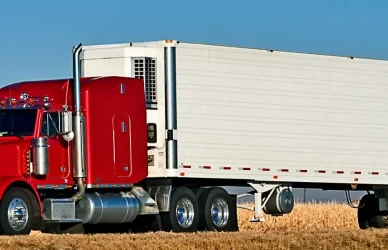If you’ve been following industry news, you’re well aware that new policies, new technologies, and new business models are accelerating the transition to a zero-emission drayage industry. A new regulation was recently posed and is expected to be approved this spring which will only allow zero-emission trucks to be added to a registry of vehicles authorized to work at California ports starting in 2024, and phasing diesel trucks out completely by 2035.
New Jersey is also taking steps to reduce emissions and electrify. These moves represent the beginning of what could turn out to be a seismic shift in the trucking industry, which accounts for a sizable contribution to greenhouse gas emissions and pollution, particularly in disadvantaged neighborhoods. The shift to electric vehicles in drayage has the potential to have an immense and positive impact on public health in communities surrounding ports.
“A lot of experts call it the diesel death zone,” says Colleen Callahan, co-executive director of UCLA’s Luskin Center for Innovation and co-author of the university’s study, which cited significantly higher rates of asthma among children living near the ports. “You have these kids going to school adjacent to rail yards and freeways where all these diesel trucks are transporting goods from the ports.”
But are we ready for this level of electric mass adoption? There are definitely some obstacles that will have to be overcome. The lack of charging infrastructure can’t be ignored, and then there’s the cost. Diesel drayage trucks aren’t cheap, and their electric counterparts come with a price tag that’s often more than double the cost of a diesel rig. Independent truckers in particular face a difficult choice: they can spend more than double on electric vehicles or gamble that diesel versions won’t be restricted anytime soon. For some, they may lack the capital to have the option, or the time to navigate Government incentives that exist to help get them into zero-emission models.
“The regulations are probably just going to get stricter,” says Rudy Diaz, founder and president of Hight Logistics in Long Beach, which runs 50 trucks a day between the ports and inland distribution warehouses. “But these electric trucks are expensive.”
Innovative startups such as Forum Mobility are bridging the gap between climate-friendly ambition and reality. The company, based in Oakland, California, aggregates rebates for electric trucks and infrastructure to purchase the vehicles and install charging depots. It then supplies the trucks and charges to drayage operators for a monthly subscription fee.
On Jan. 17, Forum announced a monumental $400 million joint venture to acquire electric trucks for drayage operators in California – financed by CBRE Investment Management and Homecoming Capital – alongside an impressive $15 million Series A funding round from Amazon’s Climate Pledge Fund and other investors.
“Small businesses all over California have the oldest and dirtiest trucks and they’re being told they must transition to zero-emission vehicles,” says Matt LeDucq, Forum Mobility’s co-founder and CEO, and a veteran of the solar industry. “But you can only do that after you monetize a plethora of incentives. Those are really hard to get, really time-consuming and really complicated, and if you’re driving a truck 12 hours a day, five or six days a week, you’re probably not applying for them.”
Available rebates that Forum can tap into can really add up. CARB offers a $150,000 voucher to offset the cost of an electric drayage truck. The federal Inflation Reduction Act can provide an additional $40,000. Some regional air districts in California provide incentives on top of these, while another state program designed to reduce the carbon intensity of transportation fuels allows owners of electric trucks to sell carbon credits to polluters. (Such regulatory credits, for instance, helped fuel Tesla Inc.’s profitability.)
In November, the California Public Utilities Commission approved a five-year, $700 million program to build charging infrastructure for heavy-duty trucks the IRA provides up to $100,000 per commercial charging station.
Rudy Diaz, founder and president of Hight Logistics is currently utilizing several trucks and charging stations supplied by Forum for a monthly fee. Diaz notes that the stress of chasing rebates and the impending implementation of more strict emissions regulations prompted him to become Forum’s first customer.
“I’m not an electric guy,” he says. “Realistically, I don’t have the time to investigate all these grants, figure out how to get the money, submit applications and do all that legwork.”
Like many drayage companies, Hight Logistics uses contract drivers and their trucks to haul freight for its shipping-company clients. The zero-emission truck directive coincides with the implementation of a California law known as AB 5, which will force many logistics companies to hire contractors as employees. That puts owners like Diaz in a double bind: He needs to bring some contractors in-house, while providing them with electric trucks to comply with the mandate, but neither he nor the drivers have the capital to electrify their existing rigs.
Andre Freeman, manager of freight policy at CARB, says companies like Forum Mobility could offer a solution to that conundrum. “I think that’s going to help out a lot of those smaller owner-operators,” he says. “Whether it’s through a subscription service or a more conventional leasing setup, a full-circle shop comes in with the vehicles and infrastructure and all you have to do is just afford the monthly payments.
Adam Browning, Forum Mobility’s executive vice president for policy and communications, says subscriptions typically cost the same or less than operating a diesel truck.
By the end of this year, Diaz plans to have 10 employee-driven electric trucks in operation, even as he notes the possible risks. “It’s all new technology so we don’t know how the trucks are going to hold up,” he says. “If they’re going to have issues, how long would repairs take and how costly would they be? If the trucks do not perform as intended, what happens then?”
Range presents another obstacle. Some of the trucks Diaz utilizes have a 150-mile range. This will work for hailing contains from ports to nearby warehouses, but not for longer runs. For those trips Diaz also has a 230-mile Volvo that is used.
Matt Schrap, CEO of the Harbor Trucking Association, says that while companies like Forum Mobility will help electricity the industry the lack of charging infrastructure at ports and warehouses will slow compliance with zero-emission regulations. “The truck is not necessarily the most difficult part, outside of the cost challenges,” says Schrap. “It’s the infrastructure deployment, which you can’t build fast enough.”
Electric truck chargers require an astronomical amount of power, and existing electrical infrastructure must be upgraded to accommodate mass adoption – a process that will cost millions and take cares.
In the meantime, other companies with similar business models are starting to pop up.
As for Diaz, he says he’s already received inquiries from shippers interested in lowering their carbon footprint by utilizing Hight Logistics’ electric big rigs. “One of the reasons we’re doing this is to do our small part to help the planet and leave a smaller footprint for the generations to come,” he says. “If this brings an advantage to us regarding customers, we welcome it.”
Source: ttnews











